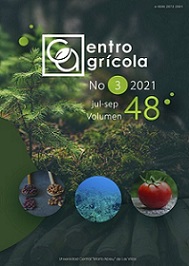CE: 1885 CF: cag072192223
RESEARCH ARTICLE
Use of traps with attractants for the monitoring of Cosmopolites sordidus and Metamasius spp. in banana barragan
Uso de trampas con atrayentes para el monitoreo de Cosmopolites sordidus y Metamasius spp. en plátano barraganete
Justo Antonio Rojas Rojas1*, Cristhian Eduardo Maldonado Vargas1, Oscar Sebastián Meza Zambrano1, Yosbel Lazo Roger2, Juan Carlos Palacios Peñafiel1
1 Universidad Laica “Eloy Alfaro” de Manabí, Facultad de Ciencias Agropecuarias, Manta, Manabí, Ecuador
2 Universidad Laica “Eloy Alfaro” de Manabí, Extensión en El Carmen, El Carmen, Manabí, Ecuador
*Autor para correspondencia: This email address is being protected from spambots. You need JavaScript enabled to view it.
ABSTRACT
The objective of this work was to evaluate two types of traps with attractants for monitoring of the black boll weevil (Cosmopolites sordidus Germar) and the striped weevil (Metamasius spp.) in the plantain crop. The treatments resulted from the combination of the two types of trap (one handmade canister 4 L and the other with pseudostem), with the four types of natural attractants, plus a control treatment. The experimental design used was a randomized complete block bifactorial arrangement (DBCA) with nine treatments and four repetitions. The monitoring of the adults captured and the reactivation of all the traps was carried out weekly. The pseudostem trap was found to have a better catch average of 3.11 black weevils and 7.81 of striped weevils. The combination of the trap of pseudostem and ripe banana fruit as attractant, turned out to be the one with the highest capture with an average of 10.82 specimens and differs significantly with the rest of the combinations. The number of specimens captured of the black boll weevil increases as temperatures decrease in the locality of El Carmen.






